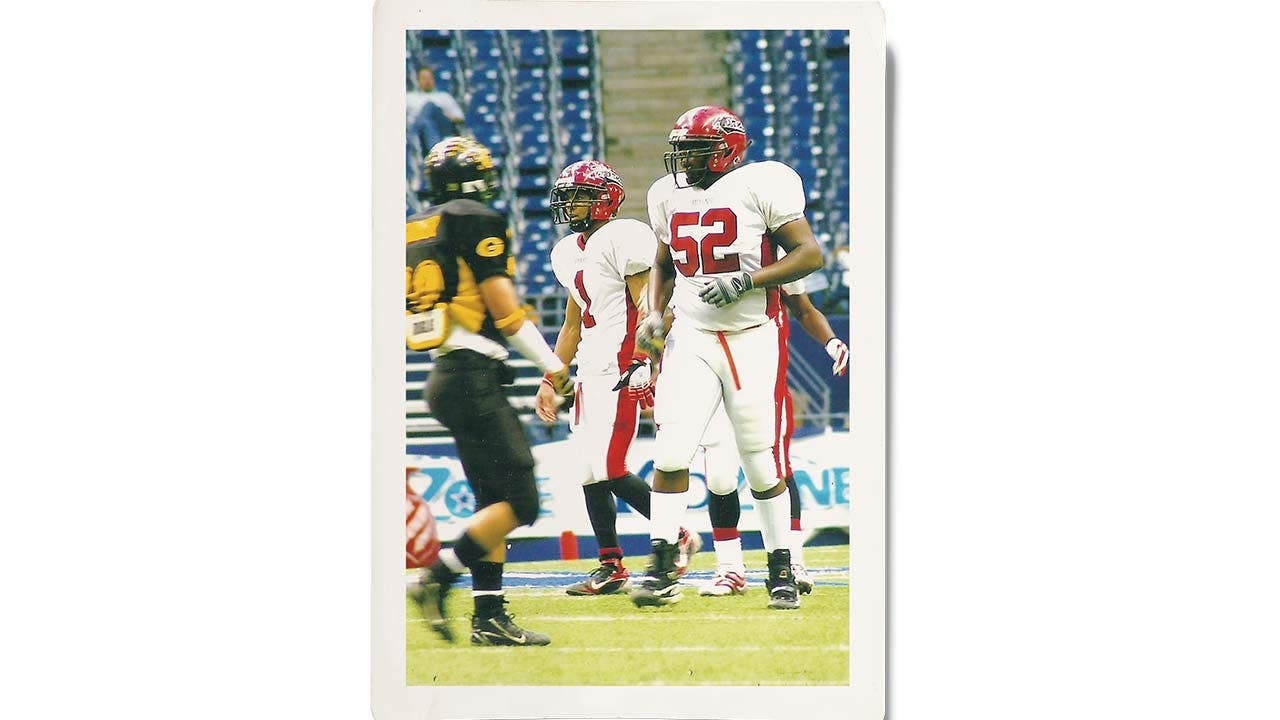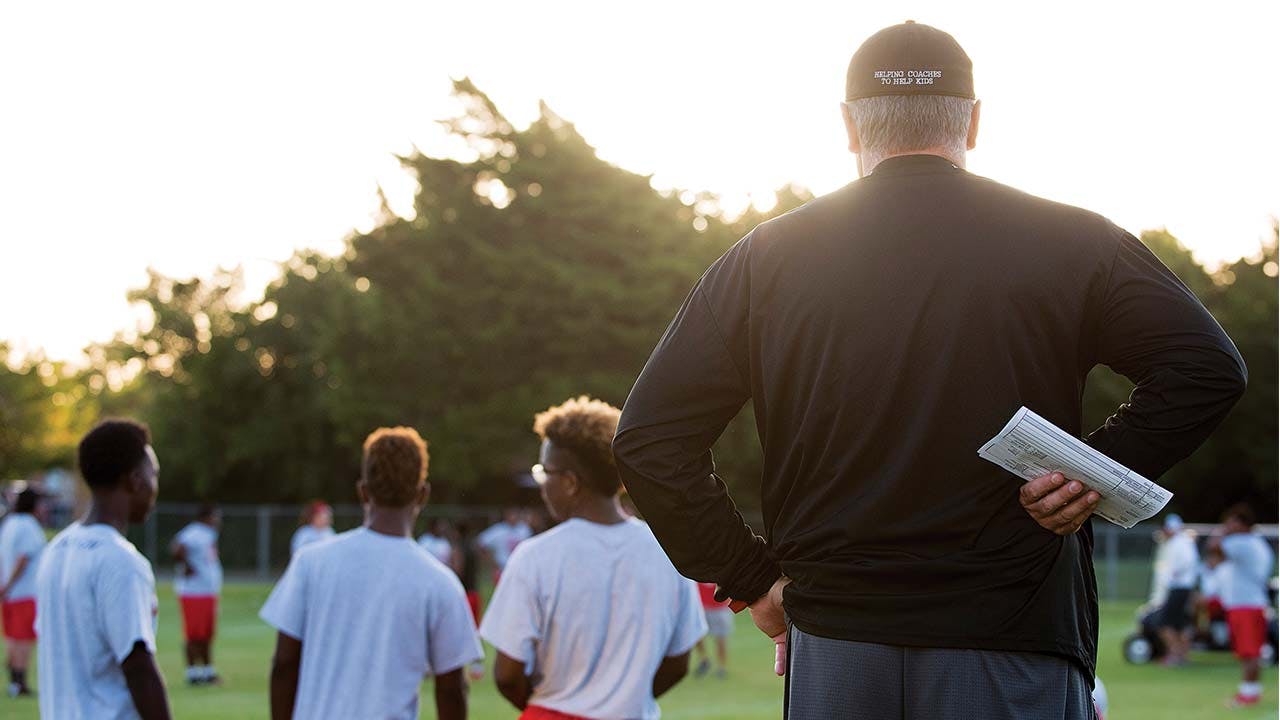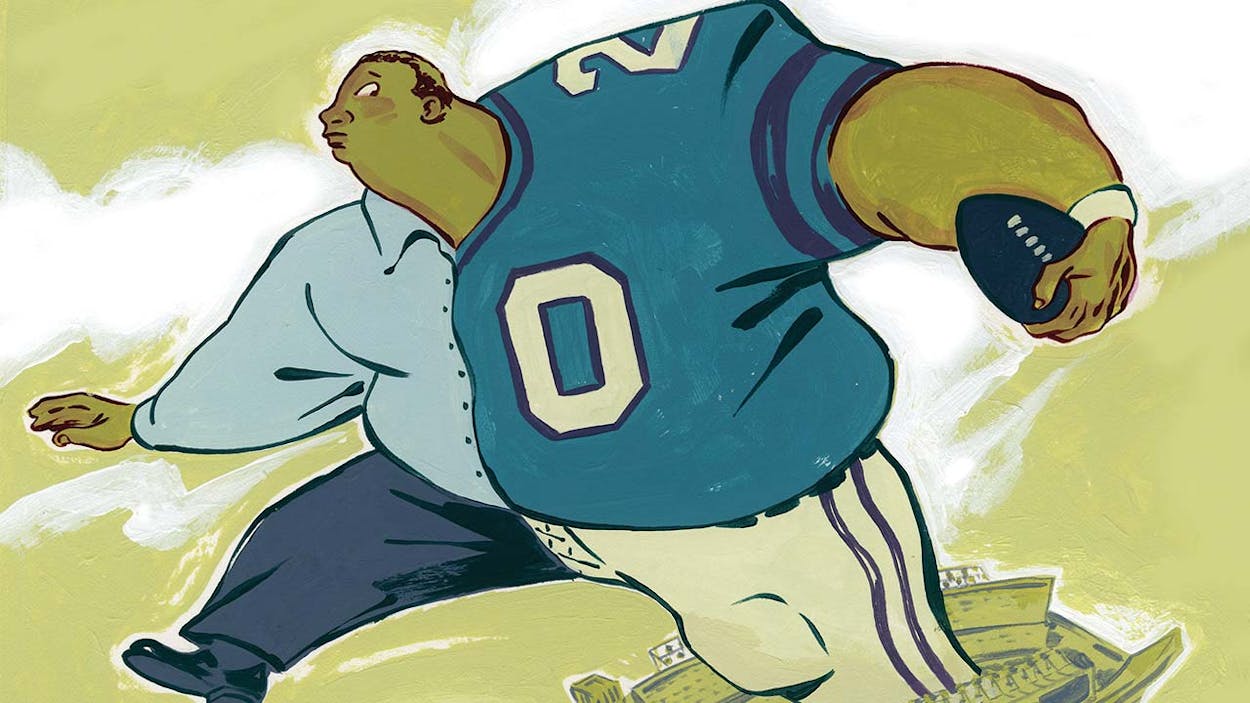The first time John Jones played football for Cedar Hill High School, he was a 240-pound freshman who knew so little about the game he trotted into Longhorn Stadium with his shoulder pads on backward. He bumbled along for weeks, unimpressive in every position he tried. During a warm-up midway through the season, he finally found his footing on the offensive line and knocked the helmet off a guy from the opposing side. After that, he was a starter.
By 2005, his junior year, the six-foot-four-inch Jones had grown into a 280-pound powerhouse and become a star. As a senior, thanks to a combination of weight training, hot Cheetos, and Quarter Pounders with cheese, he bulked up to more than 300 pounds and helped carry his team to its first state championship. In the years since, the Cedar Hill Longhorns have gone on to become one of the most decorated teams in the state, earning two more state titles and entering this year’s preseason as the top-ranked school in Texas, according to MaxPreps, a media company that covers high school sports.
Jones’s size and ability caught the attention of the coaching staff at Baylor University, and in 2007 he arrived in Waco for summer training camp. By then he was closing in on 330 pounds. He avoided the partying that felled many of his buddies and earned four letters. Still, he knew he wasn’t quite NFL material, and in 2011, just after the Baylor Bears beat the Washington Huskies in the Valero Alamo Bowl, the idea of a life without football began to sink in. A coach took him aside. “He said, ‘You need to make sure you stay active. A lot of people of color have diabetes and a lot of problems after they play ball. I don’t want to see you get to that point,’ ” Jones recalls. He was stunned. No one had ever mentioned anything like that to him. At the time, Jones estimates, he was consuming about five thousand calories a day, twice the amount a typical man needs.
After graduating, Jones eventually returned to Cedar Hill to teach middle school physical education. It’s a job he loves, but the sidelines have not been kind to his physique. At one point, he surpassed four hundred pounds. He’s only 27 but carries the white-coat anxieties of a far older man. “Since I got done playing, a doctor’s visit has been scary every time I go,” he says. “The worst thing I could hear is, ‘You have diabetes.’ ”
Jones’s worry speaks to one of the least-discussed health crises in football. As concussions and traumatic brain injuries dominate the headlines, lost in the debate is a far more insidious, unrecognized threat: the consequences of obesity. Boys and young men must be ever larger for success on the field, but once their last game ends, many are left with a jumbo-sized body and eating habits that jeopardize their health. More than a dozen studies and counting have documented how former players, most notably linemen, commonly face a high risk of cardiovascular problems, diabetes, and other metabolic concerns. “If you take a look at what happens to these players after their career is over, it’s sort of devastating,” says Jeffrey Potteiger, a professor of movement science at Grand Valley State University, in Michigan. “Their health can deteriorate quickly, unless they’re able to do something about all that excess weight. What protects them when they’re playing is the fact that they’re playing.”

To be sure, guys like Jones would be large even if they had never put on a pair of cleats. Also true is that the country faces an obesity epidemic that extends far beyond football, and involvement in youth sports is a key way to address it. What bothers many doctors is that the game has increasingly encouraged, even rewarded, big guys to pack on extra pounds—and then abandoned them. Robert W. Turner, a former pro player turned sociologist at Duke University (and the author of the upcoming book NFL Means Not for Long from Oxford University Press) has spent years questioning the escalation in size, especially in the youngest ranks. In conversations with students, he hears statements such as “ ‘I need to go out and eat pizzas all day—I’ve got a shot to get recruited, but I’ve got to get to two-ninety,’ ” he says. “And remember, this is all taking place under the guidance and the sanction of the education system.”
The gravitational center of the Longhorns is head coach Joey McGuire, who played high school ball for the Crowley Eagles and entered college to become an anesthetist, only to realize that he couldn’t bear to part with the game. At Cedar Hill he was promoted to head coach, in 2003, and has rejected numerous lucrative college offers. He attributes his team’s impressive record to “a coaching style based on love,” which may not be apparent when he’s pacing the practice field like a caged animal, spiking his cap to the ground in a sudden fury and snarling in the face of a hapless linebacker who filled the wrong gap. Yet he won’t cut players, and they shout, “I love you, Coach McGuire!” when he ambushes them with warm, effusive bear hugs.
McGuire is keenly aware that some of his linemen have become as big as boulders. On his current roster, eight players are listed at 275-plus, including a trio of 300-pounders. In part, he says, they arrive that way from middle school, and their size draws them to the line. Any athlete is better served by being bigger, stronger, and faster, he says, but for linemen extra girth is also protection, given the equally enormous bruisers they’re playing against. “When the ball’s snapped, those guys are going to get hit, or hit someone, every single play,” McGuire says. “They have to form a wall that protects the quarterback.”
If there was a tipping point in the football growth curve, Duke’s Turner pins it to November 18, 1985. That evening, during Monday Night Football, New York Giants linebacker Lawrence Taylor sacked Washington Redskins quarterback Joe Theismann, gruesomely snapping his right tibia and fibula. Coaches everywhere began to fear for their skill players. The 300-plus pound William “the Refrigerator” Perry, of the Chicago Bears, had already started to capture media fascination, but Turner believes Theismann’s career-ending break triggered an arms race to the top of the scale. Potteiger, the Grand Valley State professor, has documented it, finding that over two generations the average NFL lineman has swelled from 230 pounds to 300-plus, a trend that has accelerated over the past twenty years. The same progression can be found in high school and college players. Researchers from Tufts University reported this May in the Journal of Athletic Training that from 1956 to 2014 the size of offensive linemen playing Division III football in the Northeast increased 37.5 percent. For comparison, the weight of their non-football peers rose only 12 percent.
Potteiger doesn’t believe a ceiling exists. “I think we’ll see a continued increase in the size of players, so that it’ll be very common to have players that are three hundred and twenty-five to three hundred and fifty pounds.” One Baylor player last year weighed in at more than four hundred pounds, as much as an actual bear.
Only some of this is excess muscle, as researchers from the University of Minnesota found in 2014. Their study, published in the Journal of Strength and Conditioning Research, examined how body composition changed as the body mass index of Green Bay Packers players increased. In general, the 370 players in the study, which took place between 2006 and 2011, had a healthy ratio of fat to lean muscle. However, as the players got larger, the percentage of lean mass fell and body fat rose, especially abdominal fat, which poses the greatest health hazard. Most disturbingly, the mean fat mass of the 123 linemen in the study was about twice as much as that of players in other positions. Of the players classified as obese even after taking muscle into account, most were linemen.
New Orleans trainer Mackie Shilstone, who lists Peyton Manning among his clients, remembers when linemen began coming to him to lose weight. “What was staggering to me is that I was seeing them carry about seventy pounds of visceral fat”—which wraps itself around internal organs—“between the chin and the belly button,” he says. “I labeled them ‘the walking dead.’ ” (It’s worth noting that a Sports Illustrated writer who recently visited William Perry at his home in Aiken, South Carolina, found the 53-year-old hobbling with a walker, riddled with diabetes and other health problems.)
Studies have tended to concentrate on the NFL and college players. Few look upstream, to the country’s one million high school players, more of whom live in Texas than in any other state. The majority of those boys will finish their careers by age nineteen with little to show for their football days aside from yearbook photos and a high-calorie diet likely to trail them for a lifetime. “The average high school boy might be one hundred and eighty pounds, one hundred and ninety pounds, maybe, at the most,” Potteiger says. “You gradually gain a pound or two every year, and you wake up forty years later and you’re forty pounds overweight. By contrast, offensive and defensive linemen, because of what they’ve been asked to do, start out at two-forty or two-fifty or two-sixty and then they continue to gain weight.” Just as adolescence ends, “they’re two-eighty, two-ninety and they’re a hundred pounds overweight.”
Only recently has science begun to understand what it means to start adulthood thus burdened. Worries were raised as early as 1994, when the Centers for Disease Control and Prevention published a study of player mortality on behalf of the National Football League Players Association. That research found that as a group, players had a lower risk of early death than the general population. When the data were parsed out by position, however, linemen faced a 52 percent greater risk than the average person of dying from heart disease. The very largest players—and two thirds of linemen fell into this category—had six times the risk of heart disease compared with players of usual size. The report was controversial, with skeptics saying that the conclusions were based on a small number of heart attacks. But in 2012, a follow-up with sixteen more years of data published in the American Journal of Cardiology reached a similar conclusion: defensive linemen had a 42 percent higher risk of dying from a heart attack.
The CDC reports don’t explain why linemen might experience such an erosion of health, but other research has tried to. One thing working against these players is that, at least in the NFL, 68 percent are African American, a population that for complex reasons already has a greater prevalence of diabetes and high blood pressure. Adding to that, linemen’s large size appears to increase the risk of cardiac strain and metabolic syndrome, a constellation of issues including a bulging waistline, high blood pressure, elevated cholesterol, and other physiological shifts that can serve as a prelude to diabetes and heart disease. In 2008 a study in the Journal of Athletic Training found that among seventy college linemen studied, about half already had metabolic syndrome—before they had even graduated.
Doctors have also noted that the heart can struggle to sustain a large body. One recently published study led by Harvard University researchers found that 20 out of 64 linemen tested after their freshman year showed evidence of a condition called concentric left ventricular hypertrophy, which occurs when the muscle surrounding the heart’s main pumping chamber thickens because it is forced to work harder in response to uncontrolled high blood pressure or other stress. If this disorder persists, the muscle can lose its elasticity and ability to properly contract.
Although they make up the majority of football players, high school athletes remain the most understudied of those at risk. What happens to the countless big high school guys who don’t go on to college or the pros? “That’s what we don’t know,” says Robert M. Malina, a professor emeritus of kinesiology and health education at the University of Texas at Austin. “This is one of the big issues in studies of sport. We only study the successful athletes. We don’t study those who drop out along the way or are eliminated by the system.”
He and others contend that there is already enough evidence that coaches, parents, and football executives should have more investment in a player’s future health. “They encourage and support you becoming like this,” says Turner, “but then play no role in helping to put you back on the course for a healthy life.”
Potteiger says that protection from cardiovascular and metabolic disease should be as much a priority as ensuring fewer blows to the head. One reason they’re not is that these are gradual, undramatic killers—the results usually become apparent decades after the players have left the field and look much like the maladies that millions of other Americans suffer from later in life. There may not be any public outcry, one trainer says, until players die at younger ages. In fact, that may be starting to happen. In April, Ron Brace, a retired defensive lineman for the New England Patriots, died at age 29 likely from heart problems exacerbated by uncontrolled high blood pressure.
“How is diabetes or high blood pressure any different than a concussion, if it’s been brought about because of something the athlete needed to do to play football?” Potteiger says. “They needed him to be big. So does the NFL have some responsibility to help these individuals go through an effective weight loss program? I think you could probably make a pretty good argument that they do.”

Coach McGuire agrees that the sport has done little to help players cope with their weight once they leave the field and considers himself as guilty as any other. “When we send them to college, we try to do a lot to prepare them academically and physically,” he says. “We’re not preparing them for when the game is over.” McGuire now believes that because of their closeness and influence on young men, high school coaches and trainers should be the first to start rescuing their players from a lifetime of health issues. Yet while he often discusses concussion protocols and high-tech helmets, he concedes he’s never had a conversation with another coach about helping a big guy preserve his health after graduation.
The real danger, he believes, is not the weight on their bodies but the eating habits they carry with them. “You’ve been ingrained: bigger, bigger, bigger,” he says. “We’ve got to do a better job of talking to these kids about eating healthy and continuing to work out.” And he emphasizes an important context: all of his athletes leave high school and enter a society where one third of adults are already obese, with calorie-dense food beckoning at every street corner. That’s a hard environment for anyone, but for a three-hundred-pound twentysomething, it’s like starting in his own end zone. “If you’ve spent your entire life trying to become a bigger human being, and then you don’t need to be a bigger human being anymore, that next day you’re just not automatically going to change your habits.”
McGuire does say his training and nutrition philosophy has evolved; he now places more emphasis on players’ health while they’re still on the team. He often finds himself telling larger guys to pay attention to their bodies. The biggest member on the current Longhorns roster is the team’s six-foot-four-inch, 325-pound center, a senior with a shy smile named Zion Byrd. When he joined, he was even heavier, approaching 340 pounds, much of it around the middle. “Coach said if I wanted to start I had to get in shape,” Byrd recalls. He saw his college dreams hanging in the balance.
Byrd started spending more of his off-hours in the school’s vast weight room and, at his coach’s urging, snacking on protein smoothies instead of junk food. This summer, he rose every morning before the day’s heat set in to run a couple of miles and worked out two hours in the afternoon. As a senior he’s barrel-chested, having shed much of the belly fat that stood to threaten him for a lifetime.
From his windowless office plastered with football awards and treasured photographs, McGuire reflects on the big guys who have come through his locker room. He vows to do better by players like Byrd than he did a decade ago in John Jones’s era. “It has to be a support system,” McGuire says. “It’s got to be us at the high school level talking about it with our kids. You almost have to have an exit interview with each kid, talking to them: ‘What’s your lifestyle? What is it going to look like whenever you leave here?’ ”
Even with that, they might always be haunted by their nineteen-year-old selves. Jones has fought hard to get his weight under control but has only dropped to 365—35 pounds more than he was in his football days. Many afternoons, he drives by the intersection of U.S. 67 and FM 1382, which has a Popeyes on one corner and a McDonald’s on the other. He tries to stick to healthy fare like oatmeal and blueberries but admits that he struggles with his old habits. “I think ultimately if I stay focused I’ll be okay,” he says. Still, some days, he gives in and pulls into Popeyes.







